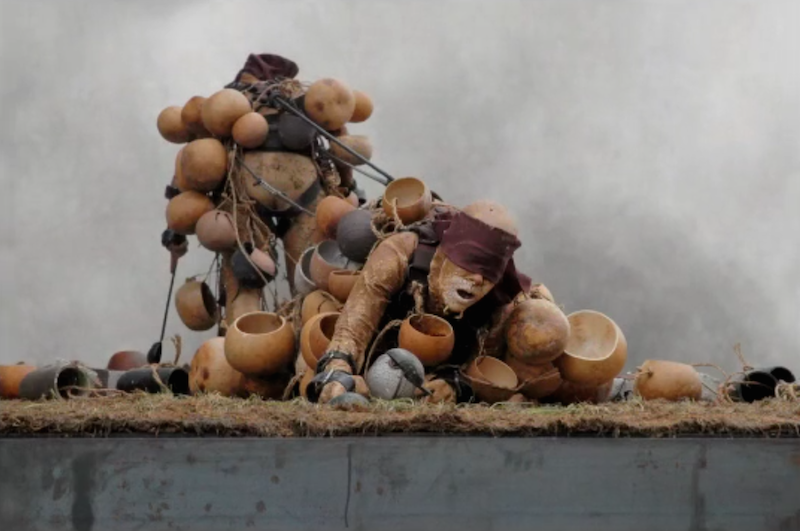WASHINGTON D.C. — Performances in clay by J.J. McCracken look like warnings, visions of a not-too-distant future in which resources and the indignities required to access them are magnified 1,000-fold. This is obvious in Hunger, Philadelphia, a performance we wrote about two years ago. Performers were coated with raw clay, giving them a ghastly pallor. They crowded, weakly, around a buffet made of clay food— abundant and yet void of nutrition.
Above image: J.J. McCracken, “Thirst, and the Martyr,” 2011. Photograph by Margaret Boozer,
As I reread McCracken’s artist statement, I started to wonder if he was on loan to us from Hades. The scenarios he creates read like the torments described in ancient myths. He makes suffering exquisite, served up with the kind of diabolical irony you’d expect from Hell. From the artist:
J.J. McCracken creates messy situations where performers grovel for access to resources. They are socially disconnected and eternally hungry. They are martyrs, misanthropes, thieves, ghosts, and the wronged.
Absurd and often painful tasks are endured as stress cracks form and failures reveal the body’s limitations. Wet, shivering, clay-covered women eat potatoes made of clay for hours; blindfolded women hoard water, hauling it in pots that leak or break; a timekeeper fills a one-directional hourglass that slowly drains.
Built from the details of extensive research, these characters interrogate our corporate landscape while examining the artist’s own patterns of consumption. Recurring themes include malnutrition, water rights, free speech, and shouldering the weight of passing time.
Thirst, and the Martyr (2011) takes what McCracken did with Hunger… and applies it to thirst and labor. Performed at Emerge Art Fair in Washington D.C., two actors were covered in raw clay and laden with clay bowls and water gourds. In the video above you can see that they are tethered together as they crawl in opposite directions on a raised platform. When one actor submits to exhaustion and stops pulling, the other actor starts to pull. Their mouths look absolutely parched, a nice touch given even more weight when you see one of the actors feebly holding out a ladle for water that is never going to come.
A theme in classical stories about damnation and suffering is that the torment requires some action on the part of the tormented; they must participate even though that participation is immediately shown to be futile. The damned do not compromise and neither does Hell. This creates the perpetual motion we see in McCracken’s performances, the sense that we could leave the space and return six years later to find the performers doing the exact same thing. McCracken suggests that these two could overcome their problems through compromise and that’s true. Larger, though, is the idea of persisting in a self-defeating act, having the awareness to know that a change needs to be made, knowing precisely what that change is and yet being unable to execute it.
I said at the beginning of this post that McCracken’s performances are like warnings. As I am still living a life in relative comfort, I wonder how long I have before the struggle above will be too painful to watch. I still have the luxury of scrolling past any article about climate change that may appear on my Facebook feed. Forbes writes articles about water investments with an alarming lack of alarm. I woke up in Santa Fe this morning with the smell of the Dog Head wildfire wafting through my window, reminding me of the summer my city was bordered on three sides by fires that burned for months. Omens abound.
Bill Rodgers is the Managing Editor of cfile.daily.
Do you love or loathe this work of contemporary ceramic art? Let us know in the comments.

Stunning.
…although I couldn’t help thinking of our Congress at this moment. Compromise is always necessary for progress.